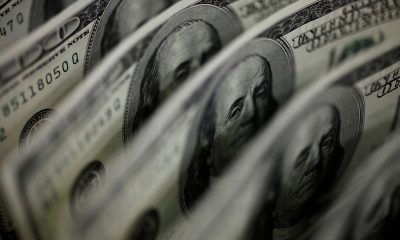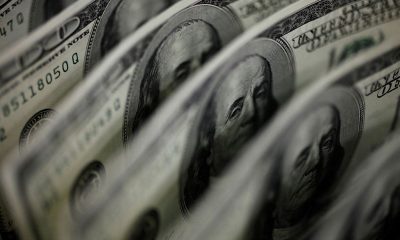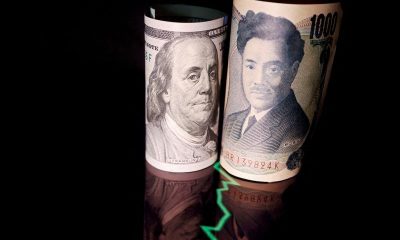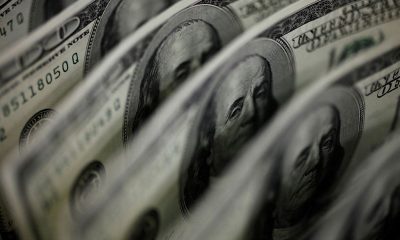Forex
Exclusive-China’s state banks act to stem yuan slide onshore and offshore -sources
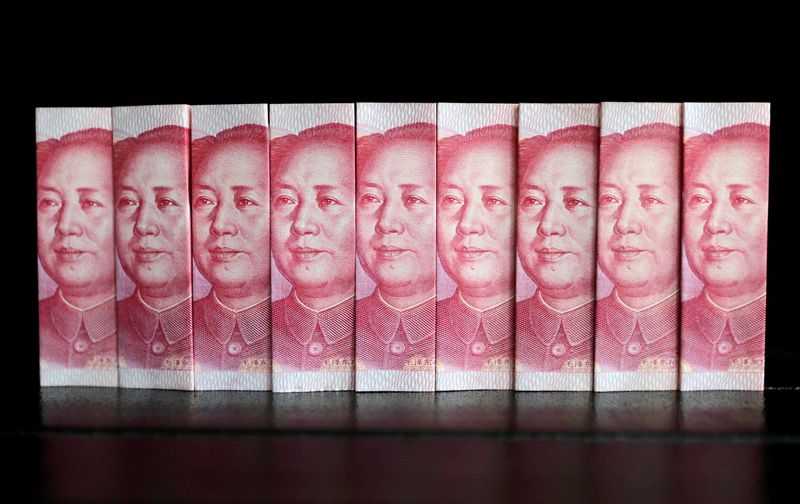
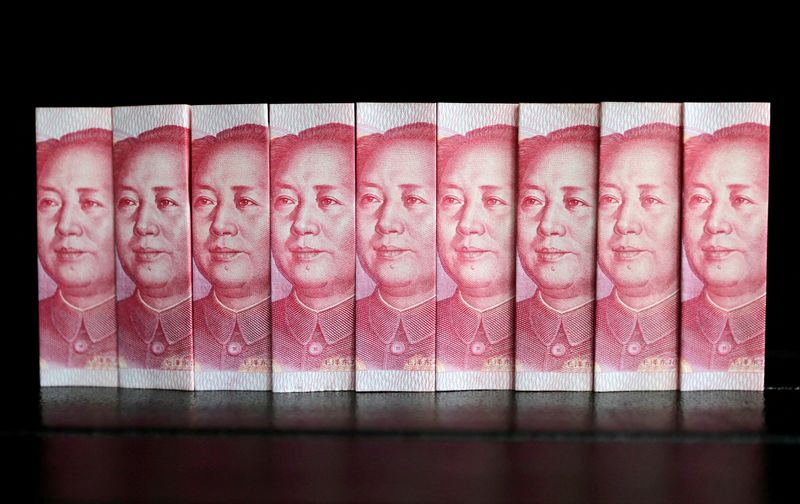
© Reuters. FILE PHOTO: Chinese 100 yuan banknotes are seen in this picture illustration taken in Beijing July 11, 2013. REUTERS/Jason Lee/File Photo
SHANGHAI/BEIJING (Reuters) – China’s major state-owned banks were active in onshore and offshore foreign exchange markets this week trying to contain the yuan’s slide, four people with direct knowledge of the matter said.
The state banks were seen swapping yuan for U.S. dollars in the onshore swap market before quickly selling those dollars in the spot market to support the yuan from Wednesday to Friday, two of the sources said.
The big banks were also curtailing their lending in markets on Friday with the aim of keeping liquidity tight, other two sources said, in a move that could raise the cost of shorting the Chinese currency.
The sources declined to be identified because they were not authorised to speak publicly about market trades.
The overnight CNH Hong Kong Interbank Offered Rate benchmark (CNH HIBOR), a gauge that measures the yuan’s borrowing cost in the financial hub, jumped to 3.3562% on Friday, its highest since Dec. 19.
The state bank actions come as the Chinese yuan faces renewed downside pressure against a globally resurgent U.S. dollar. The yuan has fallen to a three-week low against the dollar.
Increasing market expectations of an interest rate cut in the world’s second-largest economy are also weighing down the local currency. The last traded at 7.1682 per dollar.
Chinese state-owned banks usually trade on behalf of the nation’s central bank in the foreign exchange market, but they could also trade on their own behalf.
In recent months, China has sought to stabilise the yuan by orchestrating buying by state banks and giving market guidance to bankers, Reuters reported last week.
Forex
Dollar steadies as traders eye Federal Rate path following soft U.S. jobs data
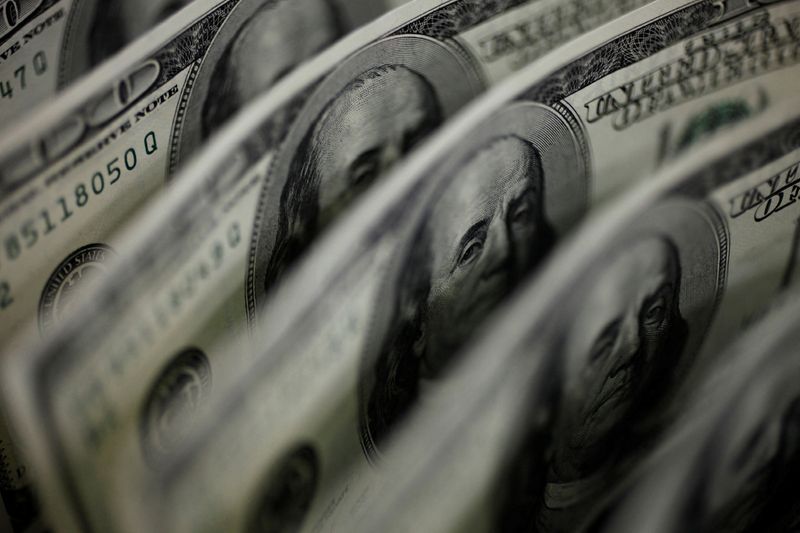
Investing.com — The U.S. dollar steadied on Monday after slumping in the prior week on weaker-than-anticipated nonfarm payrolls data, which led traders to push up the timeline for potential Federal Reserve interest rate cuts this year.
At 04:31 ET (08:31 GMT), the U.S. , which tracks the greenback against a basket of six other currencies, traded 0.04% higher at 105.07.
It had fallen last week to a more than three-week low, a decline fueled by wagers that the Fed may now choose to slash rates from more than two-decade highs as soon as September. Markets were previously betting that the central bank would roll out an initial 25-basis point reduction in November.
The soft payrolls data also put upcoming addresses by a string of key Fed officials this week squarely in focus. On Monday, New York Fed President John Williams and Richmond Fed President Thomas Barkin are both set to speak, followed by Minneapolis Fed President Neel Kashkari a day later. Chicago Fed President Austan Goolsbee and Fed Governor Michelle will make appearances later this week as well.
The euro exchanged hands 0.1% higher at $1.0769. The European Central Bank is widely tipped to roll out its own rate cut in June, although it remains uncertain what will happen with monetary policy after the meeting.
Meanwhile, the British pound traded 0.2% higher at $1.2573. Data last week showed that the U.K.’s key services sector remains in a healthy state, possibly granting the Bank of England more room to delay rate reductions.
remove ads
.
Broader Asian currencies retreated after recently gaining some ground against the dollar. But the prospect of U.S. borrowing costs remaining elevated in the near-term kept most regional currencies trading negative for the year.
The Japanese yen’s pair rose 0.6% on Monday, although trading volumes in the pair were held back by a market holiday in Japan, while the Chinese yuan’s pair fell 0.4%.
The Singapore dollar’s pair advanced 0.1%, while the Indian rupee’s pair edged up 0.1%.
Elsewhere, the Australian dollar’s pair climbed 0.3%, coming close to two-month highs as traders positioned for a Reserve Bank of Australia meeting on Tuesday. While the RBA is expected to keep rates unchanged, it is also expected to strike a hawkish chord after a stronger-than-expected inflation reading for the first quarter.
Forex
Asia FX dips as dollar steadies from payrolls plunge; yen reverses course
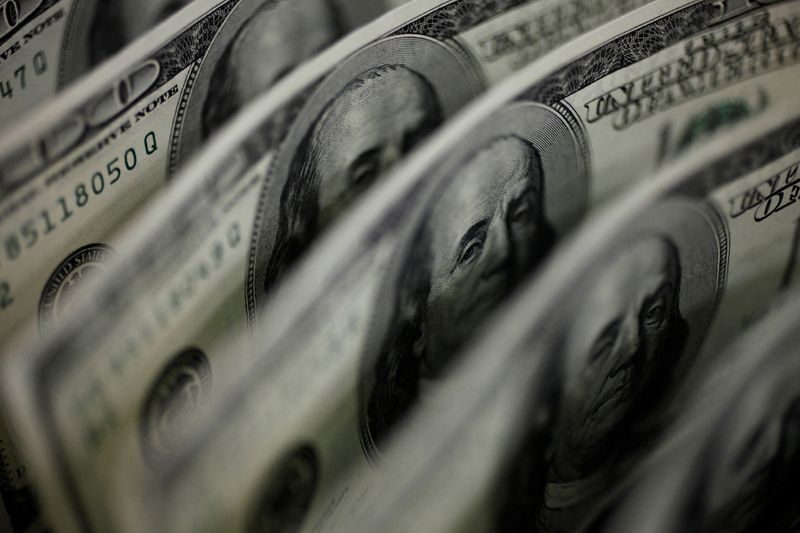
Investing.com– Most Asian currencies weakened on Monday as the dollar steadied from a tumble on Friday after weaker-than-expected payrolls data saw markets ramp up bets on interest rate cuts by the Federal Reserve.
The Japanese yen was the worst performer in Asia, reversing course after apparent government intervention last week saw the currency rebound from 34-year lows.
Most regional currencies were also sitting on strong gains from Friday, following the payrolls reading and the corresponding drop in the dollar. But the greenback found its footing on Monday.
Japanese yen reverses some gains, USDJPY rises
The Japanese yen’s pair rose 0.6% on Monday, although trading volumes in the pair were held back by a market holiday in Japan.
The pair, which is inversely related to strength in the yen, had plummeted from a 34-year high of over 160 yen last week amid signs of repeated government intervention in currency markets.
But given that the underlying factors behind the yen’s weakness- chiefly a large gap between U.S. and local rates- remain in play, bets against the yen persisted.
The USDJPY pair was now close to breaking above 154, with traders also doubting just how much capacity Tokyo had to keep intervening in markets.
Australian dollar strong, AUDUSD up before hawkish RBA
The Australian dollar’s pair rose 0.1% on Monday, coming close to two-month highs as traders positioned for a on Tuesday.
While the RBA is expected to keep rates unchanged, it is also expected to strike a hawkish chord after a stronger-than-expected inflation reading for the first quarter.
remove ads
.
Sticky inflation gives the RBA more impetus to keep rates high for longer, with some analysts suggesting the bank could even hike rates further.
Dollar steadies after payrolls-driven plunge, rate cuts in focus
The and both rose 0.1% in Asian trade after tumbling 0.8% last week. Losses in the greenback came as data read weaker than expected for April.
The data furthered bets that a cooling labor market will give the Federal Reserve more impetus to begin cutting interest rates. The showed traders ramping up their bets for a 25 basis point cut in September.
The soft payrolls data also put upcoming addresses by a string of key Fed officials this week squarely in focus.
Broader Asian currencies retreated after gaining some ground against the dollar last week. But the prospect of U.S. interest rates remaining high in the near-term kept most regional currencies trading negative for the year.
The Chinese yuan’s pair fell 0.4% on Monday in catch-up trade, as onshore yuan trading resumed after a long weekend.
The Singapore dollar’s pair rose 0.2%, while the Indian rupee’s pair rose 0.1% and back towards record highs.
Forex
Dollar drops as employers add fewer jobs than expected in April
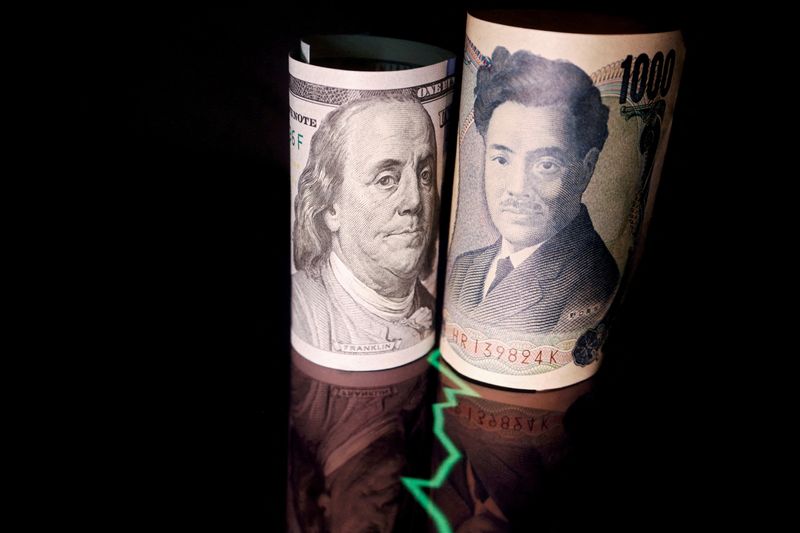
By Karen Brettell
NEW YORK (Reuters) – The dollar fell to a three-week low against the yen on Friday after data showed U.S. jobs growth slowed more than expected in April and annual wage gains cooled, boosting bets that the Federal Reserve will cut rates twice this year.
Employers added 175,000 jobs last month, below economists’ expectations for a 243,000 increase. Wages increased 3.9% in the 12 months through April, below expectations for a 4.0% gain after rising 4.1% in March.
The unemployment rate rose to 3.9% from 3.8%, remaining below 4% for the 27th straight month.
“The data’s soft across the board from the Fed’s perspective,” said Jason Pride, chief of investment strategy and research at Glenmede in Philadelphia.
Fed funds futures traders raised bets that the Fed would cut rates twice this year, with 47 basis points of easing priced in, up from 42 basis points before the data.
“The market at this point is so hoping that the Fed can cut rates this year and did not want one of the hot numbers coming in. Today’s report certainly offers them a cooler read of the labor landscape,” said Quincy Krosby, chief global strategist at LPL Financial (NASDAQ:) in Charlotte.
Still, the report itself is unlikely to sway Fed policy unless the trend continues.
“An unemployment rate of 3.9% is not something disastrous. This indicates an economy that is not declining dramatically, but it definitely indicates a looser labor market,” said Pride. “It gives the Fed some hope, but it does not establish the trend for them.”
remove ads
.
The Fed said after its two-day meeting on Wednesday that sticky inflation meant that it would take longer to cut rates.
Inflation should continue to decline even as the U.S. central bank holds its benchmark interest rate at current levels, Fed Governor Michelle Bowman said on Friday while reiterating her willingness to raise the policy rate if progress peters out or reverses.
The jobs report showed “solid” growth that slowed to a point that could make Fed officials more confident the economy is not overheating, Chicago Fed President Austan Goolsbee said on Friday.
Other data on Friday showed the U.S. services sector contracted in March, while a measure of prices paid by businesses for inputs jumped, a worrisome sign for the inflation outlook.
The was last down 0.27% at 105.03 after reaching 104.52, the lowest since April 10. The euro gained 0.39% to $1.0766.
The greenback weakened 0.48% to 152.9 Japanese yen, reaching as low as 151.86, the weakest since April 10.
The yen surged in light trading late on Wednesday and on Monday, which traders and analysts attributed to intervention by Japanese authorities.
Japanese Finance Minister Shunichi Suzuki said on Friday that authorities may need to smooth any excessive yen moves that hurt households and companies.
The yen is on track for its best weekly percentage gain against the greenback since November 2022, after Japanese authorities also intervened in October 2022 to shore up the currency.
The yen reached a 34-year low of 160.245 on Monday as it suffers from a wide interest rate differential with the dollar.
remove ads
.
In cryptocurrencies, bitcoin gained 5.30% to $61,828.

 Forex2 years ago
Forex2 years agoForex Today: the dollar is gaining strength amid gloomy sentiment at the start of the Fed’s week

 Forex2 years ago
Forex2 years agoHow is the Australian dollar doing today?

 Forex1 year ago
Forex1 year agoUnbiased review of Pocket Option broker

 Forex2 years ago
Forex2 years agoDollar to pound sterling exchange rate today: Pound plummeted to its lowest since 1985

 Cryptocurrency2 years ago
Cryptocurrency2 years agoWhat happened in the crypto market – current events today

 World2 years ago
World2 years agoWhy are modern video games an art form?

 Stock Markets2 years ago
Stock Markets2 years agoMorgan Stanley: bear market rally to continue

 Economy2 years ago
Economy2 years agoCrude oil tankers double in price due to EU anti-Russian sanctions

